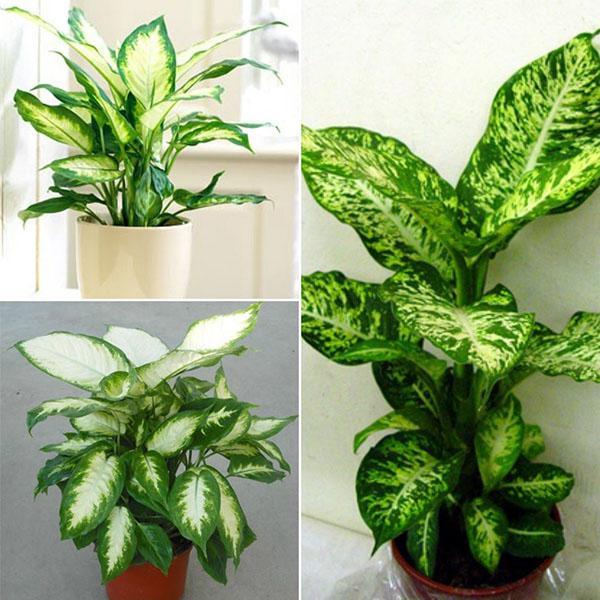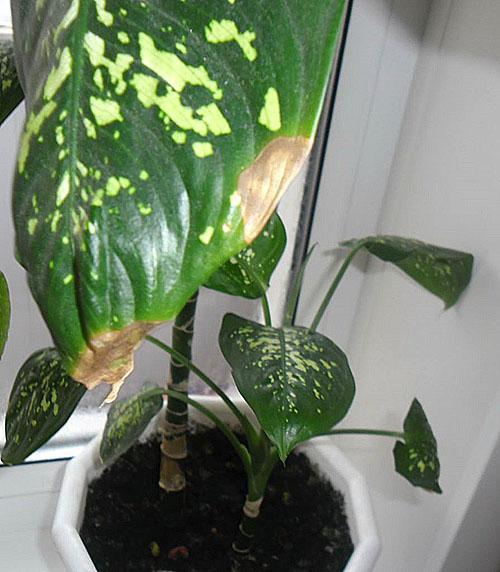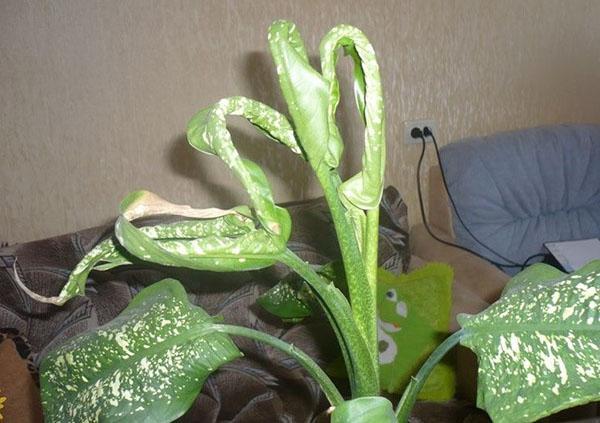Dieffenbachia diseases: how to help a tropical beauty
 Fans of lush houseplants often admire dieffenbachia, a guest of their America's humid forests. This cute flower can grow up to 2 meters in height, decorating a living space. Wide leaf plates of green color are decorated with variegated patterns, from which it is impossible to look away. They boggle the imagination, but unfortunately, various diseases of Dieffenbachia bring a lot of grief to their masters.
Fans of lush houseplants often admire dieffenbachia, a guest of their America's humid forests. This cute flower can grow up to 2 meters in height, decorating a living space. Wide leaf plates of green color are decorated with variegated patterns, from which it is impossible to look away. They boggle the imagination, but unfortunately, various diseases of Dieffenbachia bring a lot of grief to their masters.
Careful plant maintenance contributes to the successful development of Dieffenbachia, as a result of which new leaves appear on it regularly. What to do if a tropical beauty is sick? How to help a silent “household”? First of all, it is important to gain knowledge, and only then take action.
According to experts, dieffenbachia is considered a poisonous plant. If it gets on the mucous part of the body, its juice causes irritation and even allergies. It is especially dangerous for children.
Dieffenbachia diseases: general information

Another problem of the plant is drying and falling of the lower leaf plates. Since they are the main decoration of the flower, it is not very pleasant to watch their loss. In some cases, the reason is the natural process of plant development, which even the most competent florist cannot stop. But if young plates fall off, you should think about the possible dieffenbachia disease and methods of timely treatment.
 Quite an unpleasant sight when a beloved flower drops the once lush leaves and takes on a miserable look. Dieffenbachia withers for various reasons, but this appearance is a signal for action. In addition, the plant may develop brown spots, droplets of unknown origin, or even non-expanding leaves. Let us consider in detail the possible causes and methods of treating dieffenbachia diseases.
Quite an unpleasant sight when a beloved flower drops the once lush leaves and takes on a miserable look. Dieffenbachia withers for various reasons, but this appearance is a signal for action. In addition, the plant may develop brown spots, droplets of unknown origin, or even non-expanding leaves. Let us consider in detail the possible causes and methods of treating dieffenbachia diseases.
If small children live in the house, an exotic flower can be brought in the office. Such a cute "neighbor" will decorate the room with lush greenery and will always be a reason for joy.
Brown spots on leaves: causes and methods of struggle
 In one wise book, the simple truth is recorded that all living things suffer from diseases. We see the truth of these words every day. Unfortunately, plants also get sick and the tropical beauty is no exception. Research shows that it is susceptible to fungal, viral and bacterial diseases. One of them appears when brown spots are formed on the leaves of diffebachia, around which there is an orange border. Over time, they spread to the entire leaf, as a result of which it dies.
In one wise book, the simple truth is recorded that all living things suffer from diseases. We see the truth of these words every day. Unfortunately, plants also get sick and the tropical beauty is no exception. Research shows that it is susceptible to fungal, viral and bacterial diseases. One of them appears when brown spots are formed on the leaves of diffebachia, around which there is an orange border. Over time, they spread to the entire leaf, as a result of which it dies.
The main causes of the disease are caused by such factors:
- high room temperature;
- drops in humidity;
- excessive watering of the plant.
If the rules of care are followed and the listed points are not observed, then the plant is affected by a serious disease:
- anthractosis;

- fusarium;

- bacteriosis;

- bronze;

- viral mosaic.

With such problems, brown spots appear on the leaves, framed by a dark line.A fungicide solution, which should be sprayed with an infected plant, will help get rid of the disease.
In order for Dieffenbachia to get enough moisture from the air, it must be "settled" away from direct sunlight, and in the cold season, from central heating.
The best option for growing dieffenbachia is the east side of an apartment or house. Away from the sun, which burns its delicate leaves.
Leaf plates do not open: a wise solution to the problem
 Dieffenbachia has gained particular popularity for several decades. It can be found in the corridors of clinics and hospitals, offices, educational institutions and even train stations. The main reason is simple care, which consists of such activities:
Dieffenbachia has gained particular popularity for several decades. It can be found in the corridors of clinics and hospitals, offices, educational institutions and even train stations. The main reason is simple care, which consists of such activities:
- regular soil moisture;
- spraying leaf plates;
- growing a plant away from drafts;
- room temperature control;
- the right choice of habitat (away from direct sunlight).
 Despite this, the plant can get sick. Sometimes it happens that the leaves of Dieffenbachia do not open, as a result of which its beauty is lost. Often the reason lies in the following factors:
Despite this, the plant can get sick. Sometimes it happens that the leaves of Dieffenbachia do not open, as a result of which its beauty is lost. Often the reason lies in the following factors:
- direct sunlight falls on it;
- drafts that lead to sudden changes in temperature;
- decay of roots due to excessive moisture;
- low level of humidity in the room;
- lack of useful elements.
Damage to the plant by pests such as spider mites, mealybugs, aphids or shield... If "enemies" are found, the flower should be treated with soapy water. If it does not help, apply insecticides.
Dieffenbachia "cries" and does not grow
 Often, if the plant is not sick, it is distinguished by lush greenery, intensive growth and bright color of the plates. But as soon as lethargy appears, the color changes and dieffenbachia does not grow, it's time to sound the alarm. Perhaps the cause was pests or viral diseases carried by insects. As a result, yellow or brown spots are formed on the leaf plates, which adversely affect the growth of the flower. Coping with a disease can be difficult, so the best way out is to start a new plant, and say goodbye to it.
Often, if the plant is not sick, it is distinguished by lush greenery, intensive growth and bright color of the plates. But as soon as lethargy appears, the color changes and dieffenbachia does not grow, it's time to sound the alarm. Perhaps the cause was pests or viral diseases carried by insects. As a result, yellow or brown spots are formed on the leaf plates, which adversely affect the growth of the flower. Coping with a disease can be difficult, so the best way out is to start a new plant, and say goodbye to it.
Sometimes the following factors influence the growth of dieffenbachia:
- lack of light;
- "Drought" on the soil;
- the need for feeding.
An attentive attitude to the flower and simple actions will help to eliminate problems:
- moving to another place in the room;
- regular moistening of the topsoil;
- the use of special fertilizers for dieffenbachia.
Unfortunately, each of us tends to go to extremes. Therefore, excessive watering can lead to root rot and the appearance of a drop on dieffenbachia. It is interesting that in such an extraordinary way, the flower compensates for the excess moisture. Such droplets on the leaves are also found during the period of heavy rains. This is how the plant protects itself from excess fluid.
Another reason for the appearance of wateriness on leaf plates is bacteriosis. Small droplets of moisture may not be alarming at first, but if they are outlined with a visible border, it's time to sound the alarm. Subsequently, the foliage becomes brown and dies. It is better to destroy such a plant in order to prevent the spread of the disease to other indoor flowers.
Caution - Dieffenbachia!
 Despite its attractiveness, the cute tropical beauty is a poisonous plant. The sap secreted by the plant causes minor damage to the skin. But if it gets on the mucous tissue of the mouth or eyes, a burn occurs. In rare cases, complete intoxication of the body can occur, which manifests itself as follows:
Despite its attractiveness, the cute tropical beauty is a poisonous plant. The sap secreted by the plant causes minor damage to the skin. But if it gets on the mucous tissue of the mouth or eyes, a burn occurs. In rare cases, complete intoxication of the body can occur, which manifests itself as follows:
- swelling of the mouth tissues and lips;
- profuse saliva;
- rapid breathing;
- vomiting;
- diarrhea;
- temperature increase;
- tearing.
First aid for dieffenbachy burns, and treatment consists of simple steps. First you need to rinse the affected skin area with running water.For painful sensations, a solution of lidocaine is applied to the burn. If the juice gets on the eyeball, then wash the affected eye with running water for about 20 minutes. Then use drops "Levomycetin" or furacilin solution to prevent infection.
Burns resulting from dieffenbachia juice in the oral cavity are removed thanks to the rinsing procedure. A clearly expressed pain can be quenched with a solution of novocaine (0.5%). After these steps, it is recommended to drink a glass of cold milk or water. In any case, when a problem arises, it is important not to waste time, but to act.